Problems of Paper and Digital Documents Sol'ved by the Global Digital Document Exchange Program
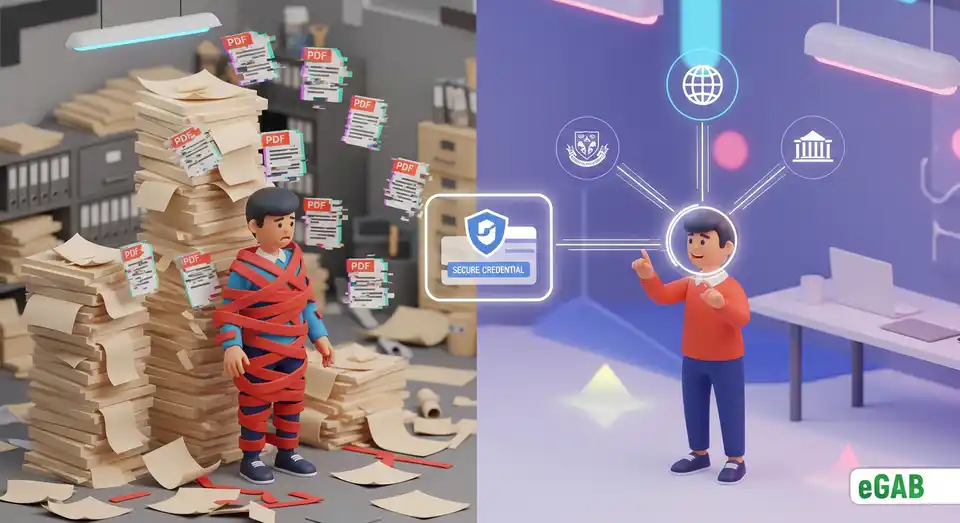
 Author:
Artem Grigoriev
Author:
Artem Grigoriev
Have you ever had that sinking feeling? That moment you realize you can't find your original diploma? Or maybe you've been through the bureaucratic nightmare of getting it verified for a job abroad.
For decades, we’ve treated paper certificates like priceless treasures. We hoped that simple digital copies, like PDFs, would be an upgrade. But the truth is, both options have critical flaws.
These everyday frustrations are just symptoms of a deeply outdated system. It's a system plagued by the constant threat of forgery . It’s burdened by crippling administrative overhead . And it's tangled in a confusing mess of incompatible document standards .
That’s exactly why The Global Digital Credentials Management Program was created. This wasn't designed to be a simple patch. It’s a systemic solution, built to fix these foundational issues from the ground up.
In this article, we'll break down the core problems of paper and digital documents. We’ll also show you exactly how the program offers a complete solution-a secure and modern answer to every one of these challenges.
📘 This post is part of our comprehensive guide to "The Global Digital Credentials Management Program". Explore it to find answers to all your questions ;)
The Pervasive Threat of Forgery and Fraud
Let me ask you a couple of questions: How confident are you that the paper diploma on an office wall is real? Or that the PDF certificate you just got hasn't been cleverly faked? Here’s a hard but crucial truth: paper documents are incredibly easy to forge. To make things worse, the built-in problems with PDF documents , which usually lack any real security, make them a prime target for fraud. Anyone can illicitly edit the most common digital files with software that's free and easy to find. This isn't just some minor annoyance; it's a massive vulnerability that creates enormous digital document security risks .
The reputation of your university or college is on the line. At the same time, employers face a constant, serious risk: they could hire someone based on a fake diploma. This one mistake means putting unqualified people into critical, high-stakes jobs. The scale of this problem is simply staggering. A recent report from The Association of Certified Fraud Examiners (ACFE) found something shocking: organizations lose about 5% of their yearly revenue to fraud. A huge, but often overlooked, part of that loss is credential fraud . This type of deception, also known as credential forgery and fraud , is especially damaging because it directly attacks the trust we all place in qualifications. The situation is only getting worse with the spread of "diploma mills"- shady online businesses that do nothing but churn out fake qualifications, devaluing every legitimate academic and professional achievement out there.
So, when the problem is built on deception, how do you fix it? People everywhere are asking, how do you solve document forgery? The only answer is to use a system where deception is simply impossible. The Global Digital Credentials Management Program's core solution is built on cryptographic security , using advanced technologies like the Global Academic Blockchain (eGAB). This leads to the next logical question: how does blockchain prevent document fraud? At its heart, blockchain technology creates a decentralized and distributed ledger, which turns each credential into a permanent and verifiable record. This process makes every credential tamper-evident (meaning any change is immediately obvious) and immutable (meaning it's impossible to alter). Once a digital certificate is issued through this system, it's sealed for good. What's more, a unique digital signature cryptographically locks each credential to both the institution that issued it and the person who earned it. Because of this, it can't be secretly changed or convincingly faked. And the best part? You can verify its authenticity with absolute certainty in just seconds, which we prove in our case study on the eGAB ecosystem. This breakthrough finally answers the key question on everyone's mind: how can I secure my digital certificates from being copied? The security is literally woven into the credential's digital DNA, making any unauthorized copy instantly invalid the moment it's checked-a world away from the weeks that manual verification often takes. Ultimately, this modern approach doesn't just stop forgery; it brings a completely new level of trust to the entire verification process.
This innovation flips the old model of "trust, but verify" to a new standard of "mathematically proven." We no longer have to depend on slow, error-prone human checks and bureaucracy to spot fakes. Instead, the system itself delivers instant, undeniable proof of authenticity. This powerful change means employers and institutions don't have to guess anymore. They can finally know with absolute certainty.
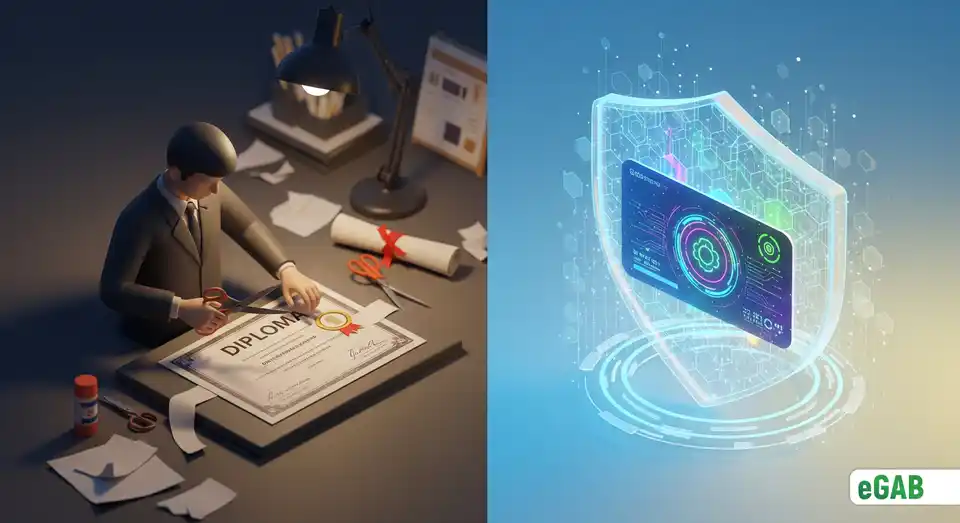
The High Barrier of International Verification
So, why is it so hard to verify international credentials? Ever tried to use your academic degree in another country? If you have, you already know the nightmare that often follows. Verifying a foreign document is frequently a long, expensive, and deeply bureaucratic ordeal. It’s a frustrating paper chase that can feel like it was designed just to slow you down.
This process isn't as simple as just showing someone a PDF. It usually involves slow-moving institutional requests and often requires you to pay for pricey international shipping for your original documents. On top of that, you'll need certified translations and complex legalizations like apostilles . This entire apostille / legalization process (a formal, but painfully slow, method for cross-border recognition) is an official certification for documents, and its rules vary wildly from one country to another. The root of this friction usually comes down to incompatible document standards and the reality that most institutions operate in secure but isolated data silos . And the result of all this friction? Missed job opportunities, delayed school admissions, and a mountain of stress.
Now, to be fair, dedicated organizations are working tirelessly on this issue. Groups like the Groningen Declaration Network are pushing hard for the global portability for digital student data. But let's be realistic: these old-school, manual processes are still a huge barrier for millions of people worldwide. This begs the question: what are the benefits of a global standard for digital documents?
This is exactly the problem the Global Digital Credentials Management Program was built to solve. It directly answers the question so many people have: how can I verify a foreign diploma online? The program doesn't force you to navigate that confusing maze. Instead, it creates a trusted, globally interoperable network for verification. This focus on true interoperability is made possible by building on universal frameworks like the W3C Verifiable Credentials data model. You can think of it as a secure digital handshake between educational institutions across the globe. Here's how it works: the system allows any authorized party-whether it’s a potential employer, a university admissions office, or a government agency-to validate a credential's authenticity instantly online. This quick and secure process is the future of certificate validation .
Once this system is in place, the need for costly physical international degree verification simply vanishes. And all the administrative friction that comes with it? Gone. A hiring manager in Tokyo, for example, can verify a degree from Berlin in seconds, and they can do it with complete confidence in its legitimacy. This transforms a process that once took months into a single click.
Moving beyond the traditional, paper-based system isn't just about convenience; it's fundamentally about opportunity. Instant, trusted verification removes the geographical barriers that have historically held back global talent. What this really does is make your skills and education truly portable. It allows you to pursue your ambitions anywhere in the world, without the heavy burden of bureaucratic delays.
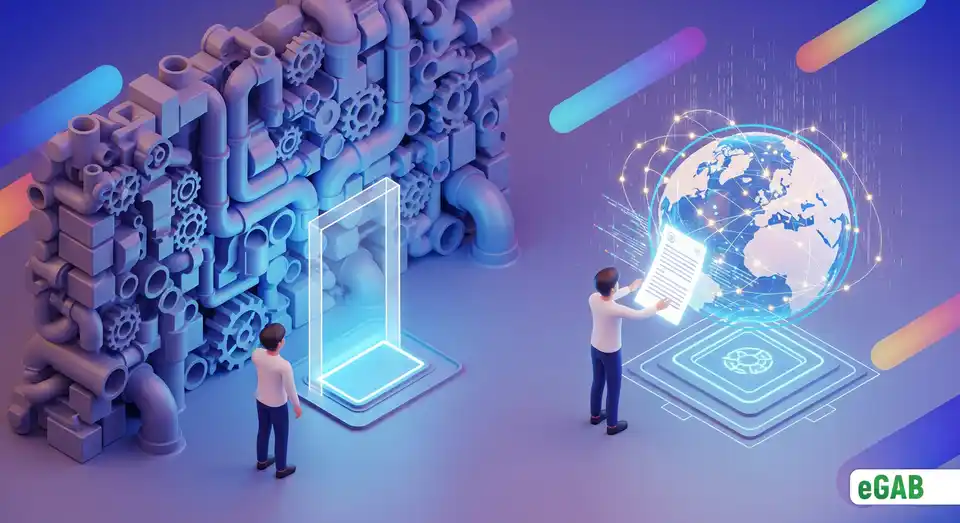
The Crushing Weight of Bureaucracy and High Costs
Let's start with a question that keeps administrators up at night: how much does managing paper documents cost institutions? We've all felt the agonizing pain of traditional paperwork. The endless forms, long waits, and the hassle of certified mail are all too familiar. For decades, these have been the classic problems with paper documents that have tormented organizations. It all adds up to a slow, expensive nightmare. For the institutions and employers who benefit from digital documents, this is far more than a simple annoyance. It’s a massive financial drain and a significant administrative overhead of paperwork .
Just think for a moment about all the hidden costs involved. You have specialized secure printing for diplomas. You have the constant maintenance of vast physical archives . You also have to cover steep international postage fees for sending documents globally. And let's not forget paying for notarization services . It all adds up, and it adds up fast. While the solution might seem obvious, many institutions face significant going paperless challenges , from the initial tech investment to the difficulty of changing long-established habits.
These huge administrative overheads divert funds away from where they're needed most. That money should be going toward what actually matters: crucial areas like teaching, research, and vital student support. It's no exaggeration to say that a large university can spend a fortune on these tasks. In fact, they might spend tens of thousands annually on postage alone . That staggering cost is just for mailing out transcripts and diplomas. What could that money do instead? It could fund new scholarships, help upgrade lab equipment, or even allow for hiring another professor.
This is exactly where a digital-first model becomes a true game-changer. Let's imagine you shift the entire process of issuing and verifying credentials online. By doing that, you unleash a huge wave of automation and efficiency into the system. This, in turn, unlocks a new level of automation / workflow efficiency that was previously unimaginable. Think about it for a second: instead of paying someone to physically print, stuff, and mail an envelope, you can issue a secure digital credential instantly with just a single click.
The impact of making this shift is nothing short of staggering. For certain administrative tasks, digital issuance and verification can dramatically slash administrative overhead, with savings of an incredible up to 70% . This isn’t just about saving a few dollars here and there. It’s about fundamentally changing how educational institutions can operate. Ultimately, this shift frees up precious resources, allowing them to reinvest that money back into their core mission: fostering education and driving innovation.
Cutting costs is about far more than just making the accounting department happy. When a university can save thousands of dollars on printing and postage, that's money that can be directly reallocated to what matters most. It can go toward student scholarships, better campus facilities, or new research initiatives. This powerful efficiency boost ultimately enriches the educational experience for everyone involved.
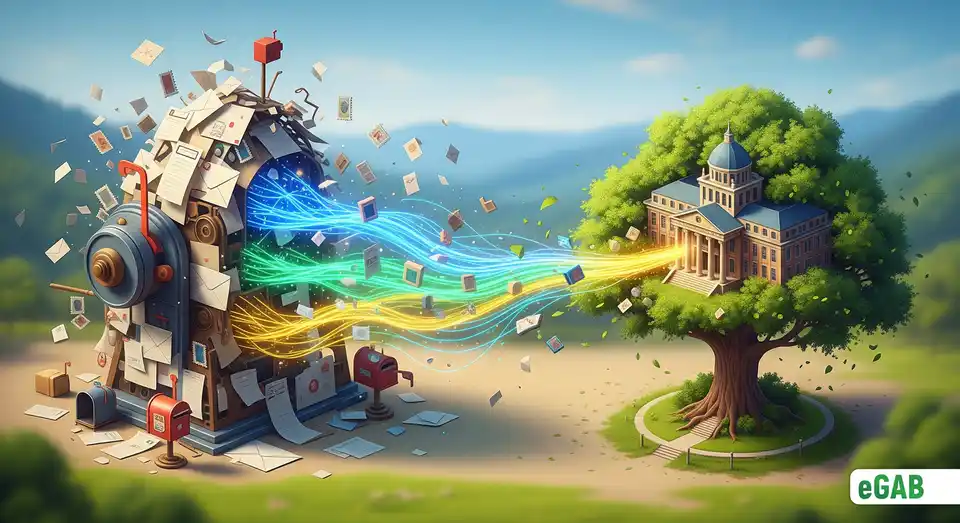
The Inconvenience and Risk for Users
We’ve all been there. You have that one special folder or box, tucked away in a closet, that holds your life’s most important documents: your birth certificate, your passport, and, of course, your diploma. For decades, we've been told to guard that piece of paper with our lives. Why? Because replacing it is an absolute nightmare. This old system puts all the responsibility-and all the risk-squarely on your shoulders. It creates a constant, low-level anxiety about the potential for loss or damage. A house fire, a flood, or even just a chaotic move could instantly wipe out the official proof of your hard-earned degree.
Then comes the moment you actually need it for a dream job or a grad school application. If you can't find the original, you're forced into a slow, frustrating process for alumni. You have to track down the right office at your old university, fill out confusing forms, and pay a fee. After all that, you wait for weeks, or even months, for a replacement to finally show up in the mail. And if you've moved to a different country? That headache turns into a full-blown migraine of international shipping and red tape.
This is the exact user-unfriendly experience The Global Digital Credentials Management Program is designed to eliminate. The program's solution is all about user-centric control and access. So, what is a digital credential wallet? Imagine this: instead of a fragile piece of paper locked in a drawer, all your credentials-from university degrees to professional certificates-are stored securely in a personal digital wallet on your phone or computer. It's built on core principles like user control over personal data, which means you are always the gatekeeper of your own information. Now, it’s crucial to understand this isn't just a scanned copy. It’s a cryptographically-sealed, 100% authentic version of your achievement. This brings up an important question: are digital diplomas valid? Yes, absolutely. They’re secured with technology that makes them more trustworthy and far easier to verify than paper.
This powerful digital credential wallet gives you lifelong, instant access to everything you've ever accomplished. This model is a key part of an emerging concept called self-sovereign identity (SSI) , where you, the individual, own and manage your own credentials. Each credential in your wallet is tied to you with a unique decentralized identifier (DID) , which is your personal, private link to that achievement. Need to prove you graduated? Forget waiting for the mail. You can share a secure, verifiable link with an employer or another institution in seconds. With this system, you're in complete control. You decide who sees your credentials, what they see, and for how long-a massive leap forward for data privacy . It’s a fundamental shift. You go from being a passive guardian of paper to the active, empowered manager of your own professional story.
Think about the difference between a physical photo album and Google Photos. One is vulnerable, hard to share, and stuck in one place. The other is secure, accessible from anywhere, and instantly shareable with anyone you choose. The Global Digital Credentials Management Program does the exact same thing for your professional achievements. It finally puts you firmly in the driver's seat.
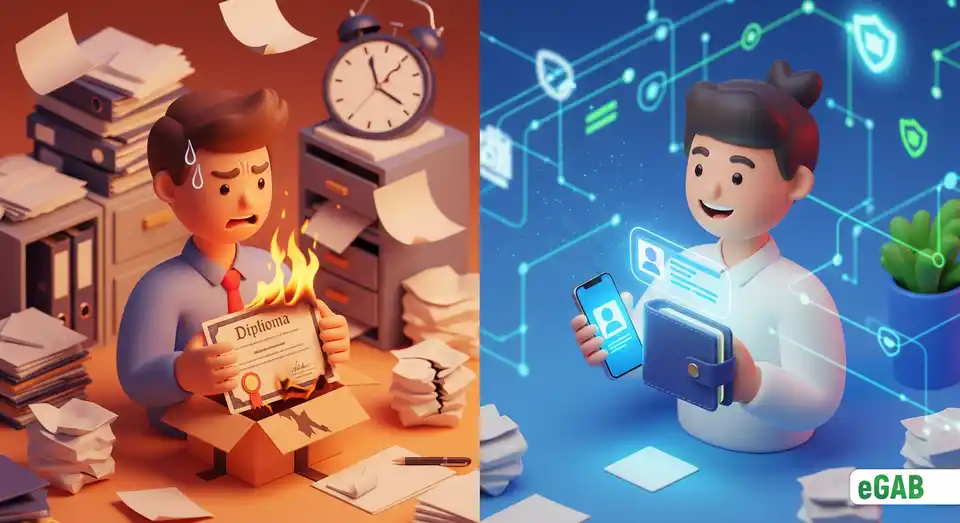
The Chaos of Incompatible Standards
Have you ever tried plugging your phone charger into an outlet in another country? You quickly discover the prongs don't fit. That's precisely the problem we face with digital documents today. Different countries and institutions use their own proprietary formats (which are just exclusive systems owned by a single company) and unique methods for verification. This situation creates a tangled web of incompatible document standards that stops these different systems from communicating with each other. This lack of a universal standard creates a digital mess, locking away valuable information in isolated "data silos" that just can't talk to one another.
Here’s the thing: this digital fragmentation actively sabotages major global efforts to create a more unified world for learners and professionals. Think about ambitious goals like those of the European Higher Education Area (EHEA) or Bologna Process . Their entire purpose is to build comparable and compatible education systems across borders. But when every university's digital diploma speaks a different "language," the goal of seamless mobility remains frustratingly out of reach. At its core, this is a problem of interoperability -or rather, a complete lack of it. It’s like building a global superhighway but only allowing one brand of car to drive on it.
So, what's the fix? The Global Digital Credentials Management Program's solution is to enforce common, open standards. Instead of letting everyone create their own locked-down system, the program champions a universal rulebook that everyone can use. Specifically, it adopts the W3C Verifiable Credentials standard, which is a perfect match for a powerful security backbone like public key infrastructure (PKI) (a framework for encrypting data and verifying identity). This isn't about creating yet another new format; it’s about getting everyone to agree on using the same one.
What this means is we can finally break down those silos. We just need to ensure that a credential from one country can be instantly understood and validated in another. This creates the foundation for a truly connected and efficient global ecosystem , which is built from six core components. It's a world where your achievements can travel as freely as you do.
Moving to a common standard makes a world of difference. It's the choice between digital dead ends and open pathways. It means your hard-earned qualifications are no longer trapped; they won't get stuck behind regional formats or institutional bureaucracy. Instead, they become universally recognized keys. And these keys can unlock opportunities anywhere on the planet.
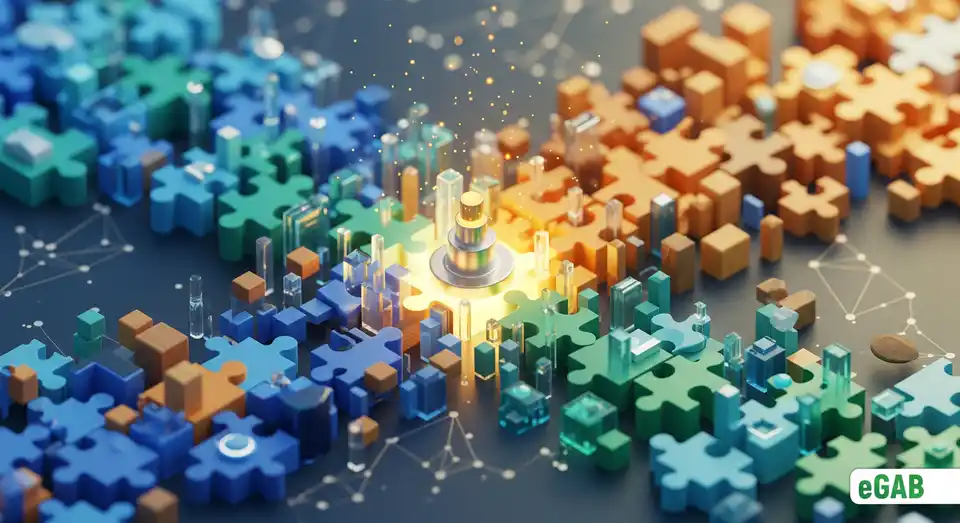
Summary: A Systemic Solution to Deep-Rooted Problems
For decades, the way we handle professional and academic credentials has been just plain broken. So, what are the main problems with paper and digital documents? We've all felt the pain of slow, clunky systems that seem designed to hold you back. Have you ever waited weeks for a transcript to be mailed? Or paid outrageous fees for a simple verification? Worried if a document was even real? If you’ve nodded along, you've personally experienced the symptoms of a much deeper problem.
The Global Digital Credentials Management Program wasn't created to just put a band-aid on these issues. Guided by six key objectives, we designed it from the ground up as a systemic solution meant to fix the entire broken foundation. Let's dive into the key benefits of digital credentials that this innovative system unlocks.
At its heart, the program directly attacks the five core failures of traditional systems, and its definition, principles, and purpose are built to solve them. First, it replaces widespread fraud with absolute trust. Instead of relying on easily faked paper and ink, it introduces immutable, cryptographically secure documents. You can think of each credential as being sealed in a digital vault that's impossible to crack or tamper with. These aren't just files; they're true global digital credentials built for a new age of trust. This revolutionary approach guarantees that what you see is always the real deal.
Next, the program demolishes the endless, frustrating red tape. It trades bureaucracy for radical efficiency by enabling instant, global online verification. With this system, the long waits are officially over. Forget phone calls, faxes, or waiting for an office to open. Now, verification is just a click away. This streamlined process of secure credential verification kills both fraud and delays at the same time. It connects opportunities across the globe in seconds, not weeks. This powerful move toward automation also fixes another huge flaw: outrageous costs. By simplifying these processes, the program frees up vital institutional resources, which in turn allows schools and organizations to reinvest their time and money. They can finally focus their energy on what they do best: their core missions.
Perhaps the most empowering change of all is the move from inconvenience to your complete control. The program takes you from being at the mercy of others to being fully in charge. In the old system, your achievements were locked away, with the institutions that issued them holding all the power. The new standard completely flips that script. It gives you lifelong access to your own verified achievements, all held securely in a personal digital wallet. Suddenly, you're in the driver's seat. You get to decide exactly who sees your credentials and for how long.
Finally, the program is expertly designed to bring order to chaos. It gets rid of a world full of disconnected and incompatible systems. In their place is a robust set of universal, interoperable standards. This crucial innovation creates a common language that everyone, everywhere can speak and understand. It ensures a degree from one country is instantly understood and trusted in another. By tackling all of these critical issues at once, this solution doesn't just build a better system-it shows you the future of digital documents. It demonstrates the profound, far-reaching impact of a unified digital document exchange .
program**. We're building a more secure, efficient, and interconnected world-one where the true value of your credentials can finally shine.
This isn't just about swapping paper for digital. It’s a complete shift in how we define trust and ownership. By fixing these deep-rooted problems, we're creating a new kind of world. It's a world where your skills and knowledge are as mobile and verifiable as you are. And that, in turn, unlocks a truly global marketplace for talent.
➡️ Ready for the solution? Having established the problem with paper credentials, it's time to dive into the specifics of the solution. Learn about the definition, principles, and purpose of the GDCP.
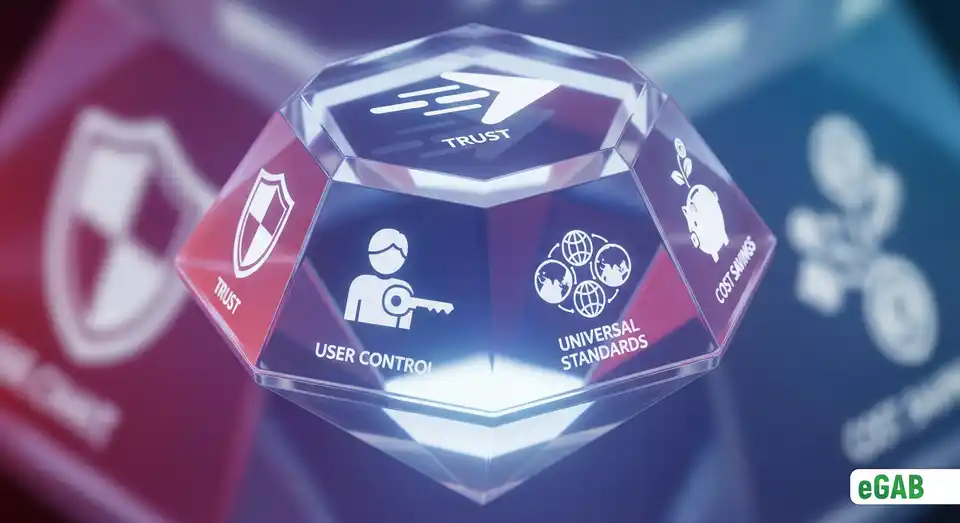
Case Study: How the eGAB Ecosystem Implements the GDCP Standard
The 6 Core Components of the GDCP Ecosystem
The Future of Digital Credentials: AI, Micro-Credentials, and the GDCP
Who Benefits from Digital Credentials? The GDCP Advantage
The 12 Foundational Principles of the GDCP
